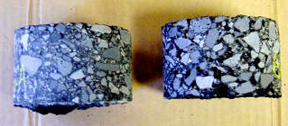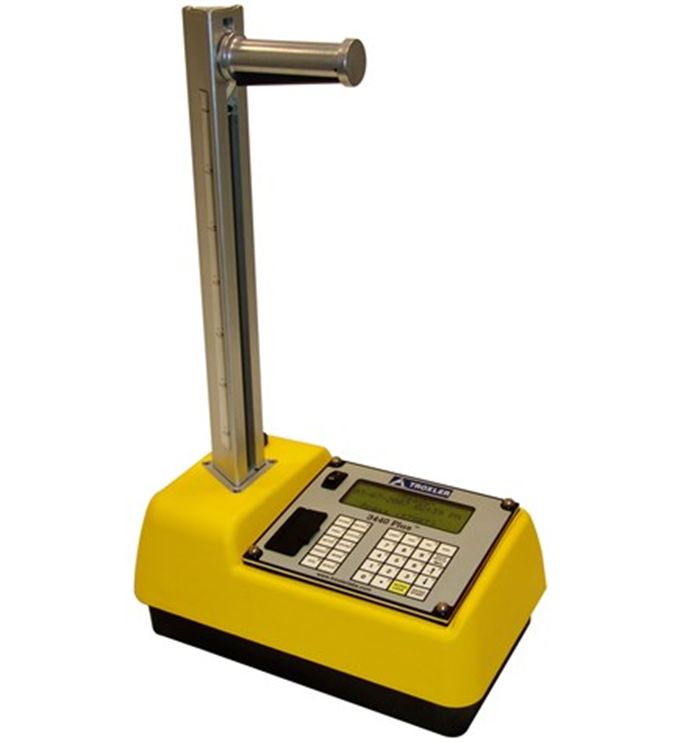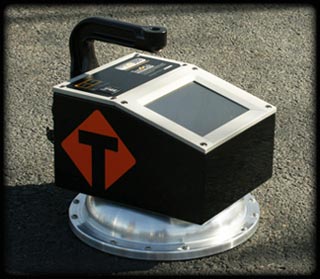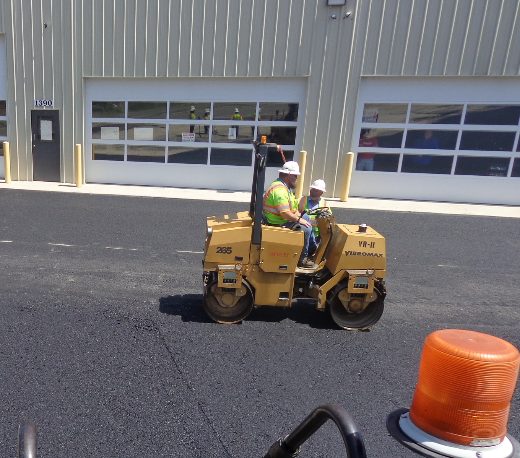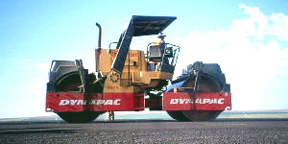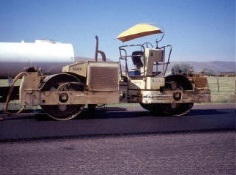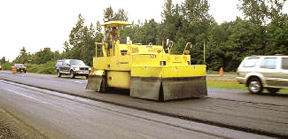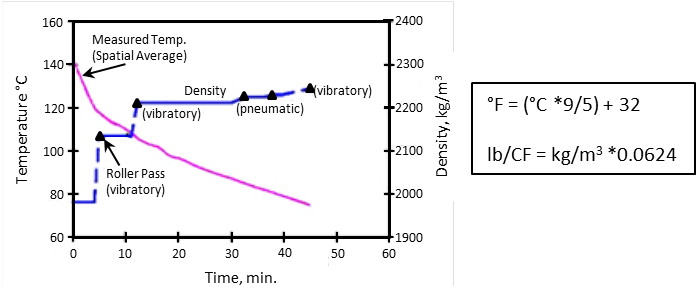Section 8: Compaction
Anchor: #i10503578.1 Introduction
The top three factors in HMA pavement construction are “compaction, compaction, and compaction.” Compaction is the process by which the volume of air in an HMA mixture is reduced by using external forces to reorient the constituent aggregate particles into a more closely spaced arrangement. This reduction of air volume in a mixture produces a corresponding increase in HMA unit weight, or density (Roberts et al., 1996). Numerous researchers have stated that compaction is the greatest determining factor in dense graded pavement performance (Scherocman and Martenson, 1984; Scherocman, 1984; Geller, 1984; Brown, 1984; Bell, et. al., 1984; Hughes, 1984; Hughes, 1989). Inadequate compaction results in a pavement with decreased stiffness, reduced fatigue life, accelerated aging/decreased durability, rutting, raveling, and moisture damage (Hughes, 1984; Hughes, 1989).
Anchor: #i10504008.2 Compaction Measurement and Reporting
Air void content is the measurement that determines the effectiveness of compaction. This measurement is expressed as a volume in terms of percent air voids of the compacted mixture. Percent air voids is calculated by dividing the test specimen’s bulk specific gravity (Ga) by its maximum theoretical specific gravity (Gr). Percent air voids is calculated by using Tex-207-F and Tex-227-F. This procedure uses a bulk specific gravity and a maximum theoretical specific gravity (also referred as Rice gravity) in the following equation:
Percent Air Voids = [1 – (Ga/Gr)] X 100
Where:
- Anchor: #SNXYHRJS
- Gr = maximum theoretical specific gravity of the particular HMA in question Anchor: #QAEVFBYU
- Ga = bulk specific gravity of the HMA in question.
This procedure requires a pavement core (usually 4 - 6 in. in diameter), which is extracted from the compacted HMA (see Figure 6-52 and Figure 6-53). This type of air void testing is generally considered the most accurate method, but is also the most time consuming and expensive.
Figure 6-52. Core extraction. © Copyright 2006 University of Washington
Figure 6-53. Two cores – the core on the right has significantly higher air voids. © Copyright 2006 University of Washington
Gr can also be used with a density gauge to measure the in-place density of the compacted pavement layer. The terms “percent air voids” and “density” are often used interchangeably. Density can be used to calculate percent air voids using the following relationship:
Air Voids = 100 - Density
Contractors can perform quality control of air voids indirectly using a portable density-measuring device such as a nuclear density gauge (see Figure 6-54) or electrical impedance measurement gauge (see Figure 6-55). Accurate calibration of these devices is critical.
Figure 6-54. Nuclear Density Gauge (Courtesy Troxler).
Figure 6-55. Electrical Density Gauge (Courtesy Transtec).
Anchor: #i10507178.3 Compaction Importance
The volume of air in an HMA pavement is important because it has a profound effect on long-term pavement performance. An approximate rule-of-thumb is for every 1% increase in air voids (above 6 to 7%), about 10% of the pavement life may be lost (Linden et al., 1989). Keep in mind that this rule-of-thumb was developed using limited project data. This rule-of-thumb applies to air voids above 6 to 7% and should be used with extreme caution. According to Roberts et al. (1996), there is considerable evidence that dense-graded mixes should not exceed 8% nor fall below 3% air voids during their service life. This is because high air void content (above 8%) or low air void content (below 3%) can cause the following pavement distresses (this list applies to dense-graded HMA and not open-graded HMA or SMA):
- Anchor: #NGNSINQY
- Decreased stiffness and strength. Kennedy et al. (1984), concluded that tensile strength, static and resilient moduli, and stability are reduced at high air void content. Anchor: #NDRJMQKF
- Reduced Fatigue Life. Several researchers have reported the relationship between increased air voids and reduced fatigue life (Pell and Taylor, 1969; Epps and Monismith, 1969; Linden et al., 1989). Finn et al. (1973), concluded “...fatigue properties can be reduced by 30 to 40% for each 1% increase in air void content.” Another study concluded that a reduction in air voids from 8% to 3% could more than double pavement fatigue life (Scherocman, 1984a). Anchor: #KTVUQSFC
- Accelerated Aging/Decreased Durability. In his Highway Research Board paper, McLeod (1967) concluded that “compacting a well-designed paving mixture to low air voids retards the rate of hardening of the asphalt binder, and results in longer pavement life, lower pavement maintenance, and better all-around pavement performance.” Anchor: #HQUHCQVF
- Raveling. Kandhal and Koehler (1984) found that raveling becomes a significant problem above 8% air voids and becomes a severe problem above 15% air voids. Anchor: #OHWPRGLH
- Rutting. The amount of rutting which occurs in an asphalt pavement is inversely proportional to the air void content (Scherocman, 1984a). Rutting can be caused by two different mechanisms: vertical consolidation and lateral distortion. Vertical consolidation results from continued pavement compaction (reduction of air voids) by traffic after construction. Lateral distortion – shoving of the pavement material sideways and a humping-up of the asphalt concrete mixture outside the wheelpaths – is usually due to a mix design problem. Both types of rutting can occur more quickly if the HMA air void content is too low (Scherocman, 1984a). Anchor: #JYXYOWTN
- Moisture Damage. Air voids in insufficiently compacted HMA are high and tend to be interconnected with each other. Numerous and interconnected air voids allow for easy water entry (Kandhal and Koehler, 1984; Cooley et al., 2002) which increases the likelihood of significant moisture damage. The relationship between permeability, nominal maximum aggregate size, and lift thickness is quite important and can change significantly as these parameters change.
Air voids that are either too great or too low can cause a significant reduction in pavement life. For dense-graded HMA, air voids between 3 and 8% generally produce the best compromise of pavement strength, fatigue life, durability, raveling, rutting, and moisture damage susceptibility.
Anchor: #i10508608.4 Factors Affecting Compaction
HMA compaction is influenced by a myriad of factors including: 1) environment, 2) mix and structural design, and 3) construction (see “Table 6-4: Factors Affecting Compaction”).
|
Environmental Factors |
Mix Property Factors |
Construction Factors |
|---|---|---|
|
Temperature |
Aggregate |
Rollers |
|
|
|
|
|
Asphalt Binder |
Other |
|
|
|
|
Environmental factors are determined by when and where paving occurs. Paving operations may have some float time, which allows a limited choice of “when,” but paving location is determined by road location, so there is essentially no choice of “where.” Mix and structural design factors are determined before construction and, although they should account for construction practices and the anticipated environment, they often must compromise ease of construction and compaction to achieve design objectives. Obviously, construction factors are the most controllable and adaptable of all the factors affecting compaction. Although some factors like haul distance/time, HMA production temperature, lift thickness, and type/number of rollers may be somewhat predetermined, other factors associated with roller timing, speed, pattern, and number of passes can be manipulated as necessary to produce an adequately compacted mat. This subsection discusses:
- Anchor: #EJTJBAGL
- temperature (the environmental factor), Anchor: #DDJCVYYB
- mix property factors.
NOTE: 8.5 Compaction Equipment and 8.6 Roller Variables discuss construction factors.
8.4.1 Temperature
HMA temperature has a direct effect on the viscosity of the asphalt cement binder and thus compaction. As HMA temperature decreases, its asphalt cement binder becomes more viscous and resistant to deformation, which results in a smaller reduction in air voids for a given compactive effort. As the mix cools, the asphalt binder eventually becomes stiff enough to effectively prevent any further reduction in air voids, regardless of the applied compactive effort. The temperature at which this occurs, commonly referred to as cessation temperature, is a function of the mix property factors in the “Table 6-4: Factors Affecting Compaction”. In some literature, it is reported to be about 79°C (175°F) for dense-graded HMA (Scherocman, 1984b; Hughes, 1989). Below cessation temperature, rollers can still be operated on the mat to improve smoothness and surface texture, but further compaction will generally not occur. Conversely, if the binder is too fluid and the aggregate structure is weak (e.g., at high temperatures), roller loads will simply displace, or “shove,” the mat rather than compact it. In general, the combination of asphalt cement binder and aggregate needs to be viscous enough to allow compaction but stiff enough to prevent excessive shoving.
Mat temperature, then, is crucial to both the actual amount of air void reduction for a given compactive effort and the overall time available for compaction. If the initial temperature and cool-down rate are known, the temperature of the mat at any time after laydown can be calculated. Based on this calculation, rolling equipment and patterns can be employed to:
- Anchor: #LENAEKQJ
- Take maximum advantage of available roller compactive effort. Rollers can be used where the mat is most receptive to compaction and avoided where the mat is susceptible to excessive shoving. Anchor: #BNTDVBFK
- Ensure the mat is compacted to the desired air void content before cessation temperature is reached. This can be done by calculating the time it takes the mat to cool from initial temperature to cessation temperature. All compaction must be accomplished within this “time available for compaction.”
The major factors affecting time available for compaction are (Roberts et al., 1996):
- Anchor: #RHIIHGQC
- Initial mat temperature. Higher initial mat temperatures require more time to cool down to cessation temperature, thus increasing the time available for compaction. However, overheating the HMA will damage the asphalt binder and cause emissions. Anchor: #TUUYLSPA
- Mat or lift thickness. Thicker lifts have a smaller surface-to-volume ratio and thus lose heat more slowly, which increases the time available for compaction. Anchor: #UXGLAQCW
- Temperature of the surface on which the mat is placed. Hotter surfaces will remove heat from the mat at a slower rate, increasing the time available for compaction. Anchor: #BTSIFDDL
- Ambient temperature. Hotter air temperatures will remove heat from the mat at a slower rate, increasing the time available for compaction. Anchor: #BDPRPANU
- Wind speed. Lower wind speeds will decrease mat heat loss by convection, which will increase the time available for compaction.
Jordan and Thomas (1976) pointed out additional factors affecting mat cool-down rate that include mat density, pavement layer thermal conductivity, specific heat, convection coefficient, incident solar radiation, and coefficients of emission and absorption of solar radiation for the pavement surface.
HMA temperature affects its binder viscosity, which affects compaction in two ways:
- Anchor: #ADBNDPSO
- the colder and more viscous the binder, the less actual amount of air void reduction for a given compactive effort, and Anchor: #KFEKATLX
- HMA can only be compacted until it reaches cessation temperature; therefore, initial HMA temperature and mat cool-down rate establish a fundamental compaction parameter for the overall time available for compaction.
Many factors influence HMA temperature and cool-down rate, including initial mat temperature, mat thickness, temperature of the surface on which the mat is placed, ambient temperature, and wind speed. Warm mix additives have been used to extend compaction time resulting from lower temperatures or thinner mix lifts that cool more rapidly.
8.4.2 Mix Properties
Mix aggregate and binder properties can also affect compaction. They do so by affecting the:
- Anchor: #HIJJGSJJ
- ease with which aggregate will rearrange under roller loads, and Anchor: #RHVQMGBY
- viscosity of the binder at any given temperature.
Gradation affects the way aggregate interlocks and thus the ease with which aggregate can be rearranged under roller loads. In general, aggregate effects on compaction can be broken down by aggregate size (TRB, 2000):
- Anchor: #JCIVEVBA
- Coarse aggregate. Surface texture, particle shape, and the number of fractured faces can affect compaction. Rough surface textures, cubical or block shaped aggregate (as opposed to round aggregate), and highly angular particles (high percentage of fractured faces) will all increase the required compactive effort to achieve a specific density. Anchor: #LVTIXTND
- Midsize fine aggregate (between the 0.60- and 0.30-mm [No. 30 and No. 50] sieves). High amounts of midsize fine, rounded aggregate (natural sand) cause a mix to displace laterally or shove under roller loads. This occurs because the excess midsize fine, rounded aggregate results in a mix with insufficient voids in the mineral aggregate (VMA). This gives only a small void volume available for the asphalt cement to fill. Therefore, if the binder content is just a bit high, it completely fills the voids, and the excess serves to (1) resist compaction by forcing the aggregate apart and (2) lubricate the aggregate, making it easy for the mix to laterally displace. Anchor: #TRIXYUXN
- Fines or dust (aggregate passing the 0.075-mm [No. 200] sieve). Generally, a mix with a high fines content will be more difficult to compact than a mix with a low fines content.
The asphalt binder grade affects compaction through its viscosity. A binder that is higher in viscosity will generally result in a mix that is more resistant to compaction. Additionally, the more a binder hardens (or ages) during production, the more resistant the mix is to compaction.
Asphalt binder content also affects compaction. Asphalt binder lubricates the aggregate during compaction. Mixes with low asphalt contents are generally more difficult to compact because of inadequate lubrication, whereas mixes with high asphalt contents will compact more easily but may shove under roller loads (TRB, 2000).
Sometimes, a combination of mix design factors produces what is known as a tender mix. Tender mixes are internally unstable within a limited mixture dependent temperature range known as the tender zone. Mixtures in this zone tend to displace laterally and shove rather than compact under roller loads. It is advisable to cease compaction of these mixtures when the mat temperature is within this zone. Compaction may resume when the mat temperature falls below the tender zone.
Anchor: #i10516878.5 Compaction Equipment
Compaction equipment compacts the HMA by two principal means:
- Anchor: #WXCBRMIM
- By applying its weight to the HMA surface and compressing the material underneath the surface contact area. Since this compression will be greater for longer periods of contact, lower equipment speeds will produce more compression. Obviously, higher equipment weight will also increase compression. Anchor: #RGHJJQCL
- By creating a shear stress between the compressed material underneath the surface contact area and the adjacent uncompressed material. When combined with equipment speed, this produces a shear rate. Lowering equipment speed can decrease the shear rate, which increases the shearing stress. Higher shearing stresses are more capable of rearranging aggregate into more dense configurations.
These two means of densifying HMA are often referred to collectively as “compactive effort." This section discusses the paver screed, the steel wheeled roller (both static and vibratory), and the pneumatic tire roller as they apply to HMA compaction. 'Compaction Sequence' discusses how each one of these pieces of compaction equipment work together in a typical construction scenario. This subsection covers:
- Anchor: #ESTQNBPN
- the paver screed, Anchor: #ICKWUHDK
- steel wheel rollers (including vibratory rollers), Anchor: #JTWECIPA
- pneumatic tire rollers.
8.5.1 Paver Screed
The paver screed has previously been discussed in 'Screed.' Of additional note here is that approximately 75 to 85% of the theoretical maximum density of the HMA will be obtained when the mix passes out from under the screed (TRB, 2000).
8.5.2 Steel Wheel Rollers
Steel wheel rollers are self-propelled compaction devices that use steel drums to compress the underlying HMA. They can have one, two, or even three drums, although tandem (2 drum) rollers are most often used. The drums can be either static or vibratory and usually range from 86 to 215 cm (35 to 85 in.) in width and 50 to 150 cm (20 to 60 in.) in diameter. Roller weight is typically between 0.9 and 18 tonnes (1 and 20 tons) (see Figure 6-56 and Figure 6-57).
Figure 6-56. Small Static Steel Wheel Roller (1.45 tons 34-inch wide drum). © Copyright 2006 University of Washington
Figure 6-57. Large Vibratory Steel Wheel Roller (18.7 tons 84-inchwide drum). © Copyright 2006 University of Washington
In addition to their own weight, some steel wheel rollers can be ballasted with either sand or water to increase their weight and thus, compactive effort. Although this ballasting is a fairly simple process (see Figure 6-58), it is usually done before rolling operations start and rarely during rolling operations. Since asphalt cement binder sticks to steel wheels, most steel wheel rollers spray water on the drums to prevent HMA from sticking, and are equipped with a transverse bar on each drum to wipe off HMA. Note, however, that this water will cool the HMA and can reduce the time available for compaction.
Figure 6-58. Filling up with water. © Copyright 2006 University of Washington
8.5.3 Vibratory Steel Wheel Roller
Some steel wheel rollers are equipped with vibratory drums. Drum vibration adds a dynamic load to the static roller weight to create a greater total compactive effort. Drum vibration also reduces friction and aggregate interlock during compaction, which allows aggregate particles to move into final positions that produce greater friction and interlock than could be achieved without vibration. Roller drum vibration is produced using a rotating eccentric weight located in the vibrating drum (or drums), and the force it creates is proportional to the eccentric moment of the rotating weight and the speed of rotation (TRB, 2000). Operators can turn the vibrations on or off and can also control amplitude (eccentric moment) and frequency (speed of rotation). Vibration frequency and amplitude have a direct effect on the dynamic force (and thus the compactive force) as shown in Table 6-5:
|
Parameter |
Typical Values |
Effect on Dynamic Force |
|---|---|---|
|
Frequency |
1,600 to 3,600 vibrations per min |
|
|
Amplitude |
0.01 to 0.04 in. |
|
The ideal vibratory frequency and amplitude settings are a compromise based on desired mat smoothness, HMA characteristics, and lift thickness. Low vibration frequencies combined with high roller speeds will increase the distance between surface impacts and create a rippled, unsmooth surface. In general, higher frequencies and lower roller speeds are preferred because they decrease the distance between surface impacts, which:
- Anchor: #TSSBVOOO
- increases the compactive effort (more impacts per unit of length), and Anchor: #UKVAOYNF
- provides a smoother mat.
The recommended impact spacing is (10 – 12 impacts/ft.). Table 6-6 shows basic guidance for vibratory settings.
|
HMA/Mat Characteristics |
Frequency |
Amplitude |
|---|---|---|
|
Thin Lifts (< about 1.25 in.) |
Operate in static mode. Under vibratory mode, as the pavement increases in density, the drums may begin to bounce, which may cause the HMA to shove and become less dense. Also, some of the aggregates may be crushed. In some cases, vibratory mode may be allowed to obtain a smooth transition or joint density. |
|
|
Lifts between 1.25 and 2.5 in. |
High frequency |
Low amplitude |
|
Lifts beyond 2.5 in. |
High frequency |
Higher amplitude |
|
Stiff (more viscous) HMA |
High frequency |
Higher amplitude |
As a general rule-of-thumb, a combination of speed and frequency that results in 30 – 35 impacts/m (10 – 12 impacts/ft.) is good. At 3,000 vibrations/min., that gives a speed of 2.8 – 3.4 mph.
When density is difficult to quickly achieve with a vibratory steel wheel roller, the tendency may be to increase vibratory amplitude to increase compactive effort. However, high amplitude is only advisable on stiff mixes or very thick lifts that can support the increased amplitude without fracturing the constituent aggregate particles. For typical mix types and lift thicknesses, a better solution is usually to maintain low amplitude vibrations and increase the number of roller passes at low amplitude.
Vibratory steel wheel rollers offer potential compaction advantages over static steel wheel rollers, but they also require the operator to control more compaction variables (amplitude, frequency, and vibratory mode use) and, in certain situations, they must be used with caution (e.g., over shallow underground utilities, in residential areas, thin overlays).
In general, steel wheel rollers provide the smoothest mat finish of all compaction equipment. When operated in the vibratory mode, they also provide substantial compactive effort.
8.5.4 Pneumatic Tire Rollers
The pneumatic tire roller is a self-propelled compaction device that uses pneumatic tires to compact the underlying HMA. Pneumatic tire rollers employ a set of smooth (no tread) tires on each axle; typically four on one axle and five on the other. The tires on the front axle are aligned with the gaps between tires on the rear axle to give complete and uniform compaction coverage over the width of the roller. Compactive effort is controlled by varying tire pressure, which is typically set between 60 psi and 120 psi (TRB, 2000).
Asphalt binder tends to stick to cold pneumatic tires but not to hot pneumatic tires. A release agent (like water) can be used to minimize this sticking; however, if asphalt binder pickup (the asphalt binder sticking to the tires) is not permanently damaging the mat, it is better to run the roller on the hot mat and let the tires heat up to near mat temperature. Tires near the mat temperature will not pick up an appreciable amount of asphalt binder. Insulating the tire area with rubber skirts or plywood helps maintain the tires near mat temperature while rolling (see Figure 6-59).
Figure 6-59. Pneumatic Tire Roller (notice rubber skirt insulation around tire area as well as tire marks left in the new mat in front of the roller). © Copyright 2006 University of Washington
In addition to a static compressive force, pneumatic tire rollers also develop a kneading action between the tires that tends to realign aggregate within the HMA. This results in both advantages and disadvantages when compared to steel wheel rollers:
- Anchor: #LVWJHVKN
- Advantages (Brown,
1984)
- Anchor: #RPVUTCXM
- They provide a more uniform degree of compaction than steel wheel rollers. Anchor: #HSDTYJWA
- They provide a tighter, denser surface, thus decreasing permeability of the layer. Anchor: #UANMDARM
- They provide increased density that many times cannot be obtained with steel wheeled rollers. Anchor: #WRVPEHEJ
- They compact the mixture without causing checking (hairline surface cracks), and they help to remove any checking that is caused with steel wheeled rollers.
Anchor: #EXSTAWRJ - Disadvantages
-
Anchor: #JQLQYYWE
- The individual tire arrangement may cause deformations in the mat that are difficult or impossible to remove with further rolling. Thus, they should not be used for finish rolling. Anchor: #UBCOGTMF
- If the HMA binder contains a rubber modifier, HMA pickup (mix sticking to the tires) may be so severe as to warrant discontinuing use of the roller.
In summary, pneumatic tire rollers offer a slightly different type of compaction than steel wheel rollers. The arrangement of multiple tires on both axles serves to both compress and knead the mat, which may or may not be advantageous over steel wheel rollers.
Anchor: #i10526518.6 Roller Variables
There are several variables associated with rollers that can be adjusted from job to job. These variables are:
- Anchor: #LEPSGTQG
- sequence and number of rollers, Anchor: #VTJSHJLJ
- roller speed, Anchor: #XLNTJWJL
- number of roller passes over a given area of the mat, Anchor: #QMBXNBWH
- location at which each roller works, Anchor: #STRPURQO
- pattern that each roller uses.
Not all these variables are infinitely adjustable, but by adjusting a combination of them. a rolling plan can be developed that will optimize mat compaction.
8.6.1 Compaction Sequence
HMA compaction is typically accomplished by a sequential train of compaction equipment (see Figure 6-60). This allows each piece of equipment to be used only in its most advantageous application, resulting in a higher quality mat (both in density and in smoothness) than could be produced with just a single method of compaction.
Figure 6-60. Breakdown and Intermediate Rollers. © Copyright 2006 University of Washington
A typical compaction train consists of the following (in order of use):
- Anchor: #MHLAMBBW
- Screed. The screed is the first device used to compact the mat and may be operated in the vibratory mode. Anchor: #KFKUNYTV
- Breakdown Roller. The breakdown roller is the first roller behind the screed and, therefore, generally affects the most density gain of any roller in the sequence. Breakdown rollers can be of any type, but are most often vibratory steel wheel and sometimes pneumatic tire. Anchor: #UEGPUQDO
- Intermediate Roller. The intermediate roller is used behind the breakdown roller if additional compaction is needed. Pneumatic tire rollers are sometimes used as intermediate rollers because they provide a different type of compaction (kneading action) than a breakdown steel wheel vibratory roller. This can help further compact the mat or, at the very least, rearrange the aggregate within the mat to make it receptive to further compaction. Anchor: #AJKGJSLK
- Finish Roller. The finish roller is last in the sequence and is used to provide a smooth mat surface. Although the finish roller does apply compactive effort, by the time it comes in contact with the mat, the mat may have cooled below cessation temperature. Static steel wheel rollers are almost always used as finishing rollers because they can produce the smoothest surface of any roller type. Anchor: #EHMMITGN
- Traffic. After the rollers have compacted the mat to the desired density and produced the desired smoothness, the new pavement is opened to traffic. Traffic loading will provide further compaction in the wheel paths of a finished mat. For instance, a mat compacted to 8% air voids and then opened to heavy traffic (e.g., an interstate freeway) may further compact to about 3 to 5% air voids in the wheel paths over time.
Each position in the roller train (breakdown, intermediate, and finish) may be performed by one roller or several rollers in parallel. For instance, a large paving project may use two vibratory steel wheel rollers for breakdown rolling, one pneumatic tire roller for intermediate rolling, and two static steel wheel rollers for finish rolling. The determination of the best rolling sequence and the number of rollers is generally made on a case-by-case basis and depends upon the desired final air voids, available rollers and their operating parameters, rolling patterns, mix properties, and environmental conditions.
8.6.2 Roller Speed
Rollers are slow; the fastest operating speeds may reach about 11 km/h (7 mph). In order to provide complete and uniform mat compaction, rollers should be operated at a slow, constant speed. Operating at high speeds will reduce compactive effort, while varying roller speed can cause non-uniform compaction. The following table shows typical roller speeds; Item 210 gives typical roller compaction parameters by material type for use on TxDOT jobs.
|
Type of Roller |
Breakdown |
Intermediate |
Finish |
|---|---|---|---|
|
Static Steel Wheel |
2.0 – 3.5 mph |
2.5 – 4.0 mph |
3.0 – 5.0 mph |
|
Pneumatic |
2.0 – 3.5 mph |
2.5 – 4.0 mph |
4.0 – 7.0 mph |
|
Vibratory Steel Wheel |
2.0 – 3.0 mph |
2.5 – 3.5 mph |
not used |
As mentioned previously, roller compactive effort comes in two forms:
- Anchor: #WXFCQAKY
- material compression under the surface contact area, and Anchor: #YMQLIILW
- shear stress between the compressed area and adjacent uncompressed areas.
Operating at lower speeds allows the roller to remain in contact with a particular mat location longer than it would at higher speeds. This results in more compression per roller pass and, therefore, increases compactive effort. Speed also affects the magnitude of shear stress developed. Lower speeds result in the shearing force between compressed and uncompressed areas being applied for a longer period of time for a particular area (giving a lower shear rate), which results in a higher shear stress. The higher the shear stress, the better able it is to rearrange aggregate into a denser configuration. Therefore, as roller speed decreases, shear stress increases and compactive effort increases.
Because speed affects compactive effort, varying roller speed will vary compactive effort, resulting in uneven compaction. Varying roller speed typically occurs when operators are not closely monitoring their speed or when they speed up to roll an area more quickly so that they can keep pace with the paver. If the mat is being laid down at a faster rate than it can be rolled, the solution should not be to speed up the rollers but rather should involve one of the following options (TRB, 2000):
- Anchor: #QCMFCSEJ
- Slow down the paver. This may involve adjusting production and material delivery rate as well. Anchor: #KWHYVSOQ
- Use more rollers. Adding rollers can increase the number of roller passes in a given time without reducing the compactive effort per pass. Anchor: #XUIVQTNW
- Use larger, wider rollers. Wider rollers allow greater coverage per pass.
Finally, rollers should not be stopped on a fresh mat because they can cause large indentations that are difficult, if not impossible, to remove.
Roller speed directly affects compactive effort. The best compactive effort and most uniform densities are achieved by slow, consistent roller speeds. If rollers cannot keep up with the pace of the paving operation, they should not be operated at higher speeds because this reduces compactive effort. Rather, the paving operation should be slowed or more/larger rollers should be used.
8.6.3 Number of Roller Passes
Generally, it takes more than one roller pass over a particular area to achieve satisfactory compaction. A roller pass over a specific mat area is defined as one complete trip over the area in question by the entire roller. This means that if the roller uses two steel drums, both drums must travel over the area in question to make “one pass.” In general, earlier passes over hotter HMA will increase density (decrease air voids) more than later passes over cooler HMA (see Figure 6-61).
|
Supporting Data: Graph and data taken from Chadbourn et al. (1998). |
|
Figure 6-61. Density and Measured Mat Temperature vs. Time (note the increase in density for each roller pass) (Chadbourn et al., 1998). © Copyright 2006 University of Washington
- Anchor: #JBOSDXDF
- Test Strip
- Anchor: #GRLXPNUG
- Contractors will often (and are sometimes required to) construct a “test strip” to help determine the necessary number of passes. Anchor: #QDDYDUOG
- A test strip is a small section of mat laid out at the beginning of a project with the purpose of determining the best roller type, sequence, number of passes, and rolling pattern to use.
Anchor: #TJSSCJJV - Intelligent Compaction (IC). To date, the benefit of using IC for HMA lifts has been more related to uniform coverage by mapping number of desired passes than any contribution in meeting density. This is because current IC systems lack the necessary sensitivity to distinguish incremental benefit to improving density in typical relatively thin HMA lifts.
8.6.4 Rolling Location
Determining where the different rollers in the train should physically be is actually a question of mat temperature and roller characteristics and not one of physical distance. 'Compaction Sequence' under 8.6 Roller Variables described the roller sequence and its reasoning while this section describes some more general rules-of-thumb.
In general, the greatest compaction per roller pass can be achieved directly behind the paver because the mat is the hottest and least viscous in that position. Therefore, the breakdown roller(s) should operate as close to the paver as possible to achieve the most compaction per roller pass. Likewise, the intermediate roller(s) and finish roller(s) should be placed on the mat at a safe distance from the roller in front of them and begin rolling as soon as possible. Sometimes, when a tender mix is placed, these general rules do not apply.
8.6.5 Roller Pattern
The roller pattern combines roller sequence, speed, number of passes, and location to provide complete coverage of the entire mat in such a manner that results in:
- Anchor: #FKIJXMCE
- uniform compaction to a specified level of air voids, Anchor: #WPSQWVJW
- acceptable surface smoothness, and Anchor: #TQNXQAQF
- complete compaction before cessation temperature is reached.
Uniform compaction depends on getting the same number of roller passes over each area of the mat. This means that a pattern must be developed that covers the entire mat with an equal number of roller passes from each type of roller. For example, if two vibratory steel wheel rollers are operating as the breakdown rollers, they must work together so each portion of the mat receives the same number of passes. Since they are the same type of roller, it is not necessary for each roller to cover the entire mat. If two different rollers, such as a vibratory steel wheel roller and a pneumatic tire roller, are performing breakdown rolling, each roller should cover the entire mat an equal number of times, otherwise compaction may be non-uniform. Although roller patterns can vary widely, some general rules-of-thumb are:
- Anchor: #CGSHURRJ
- Overlap between two successive passes should be at least 15 cm (6 in.) (Roberts et al., 1996; Ingersoll-Rand, 2001). This ensures that small steering inaccuracies do not leave gaps between successive passes. Anchor: #POMFUGIH
- The roller should be turned slightly to the side when reversing directions or stopping. Rollers tend to create a slight bow hump when moving and will leave this hump in place when reversing directions or stopping. Often, it is difficult to flatten out this hump on subsequent passes if it is perpendicular to the direction of roller travel. By turning the roller slightly before changing direction or stopping, the resulting hump will be diagonal to the direction of roller travel and easier to flatten out with subsequent passes. However, hard steering should be avoided because it can tear or shove the mat. Anchor: #SNAWXKQA
- Roller passes should end at different points to prevent developing a hump (caused by the direction change) that spans the entire transverse length of the mat. Anchor: #QCFHHQUD
- Where there is an unconfined edge on the mat, the first roller pass should stay about 0.15 – 0.30 m (0.5 – 1 ft.) away from the mat edge. The small resultant strip of uncompacted mat helps confine the rest of the mat and minimize lateral displacement near mat edges. This strip should then be compacted on the next roller pass (Ingersoll-Rand, 2001). Anchor: #YDTXGDHS
- Do not roll over a designed crown in the road. Rolling over a crown will flatten it out. Anchor: #QIDLXBGH
- When compacting a longitudinal joint, the first roller pass should be entirely on the hot mat about 0.15 – 0.30 m (0.5 – 1 ft.) away from the joint. On subsequent passes, the roller should travel mostly on the newly constructed mat and only overlap the older mat by about 0.15 m (0.5 ft.) (Roberts et al., 1996; Ingersoll-Rand, 2001). Anchor: #PSGUTLRF
- Joints should be compacted with the roller operating parallel to the joint. Although transverse joints cannot always be compacted this way, perpendicular rolling does not compact the hot/new side as well. Anchor: #NESOHOFU
- For steel wheeled rollers, operate the powered wheel on the paver side. This will minimize humps that can be caused by the drive wheel.
The above guidelines are just general rules of thumb; other methods may work. However, without a clear roller pattern, the center of a lane typically receives more roller passes than the outsides. This is of particular concern because most wheel loads occur nearer the edges of any particular lane in the wheel paths. In summary, any method that achieves uniform coverage, acceptable density, and acceptable smoothness without damaging the mat can be considered a good method.
Anchor: #i10534968.7 Summary
Although compaction looks like a simple job, it is far from it. Variables such as sequence, speed, number of passes, location, pattern, and mat temperature make it quite complex. All these variables have a profound effect on air voids and thus pavement performance. Simply put, good compaction is essential to quality pavement.

